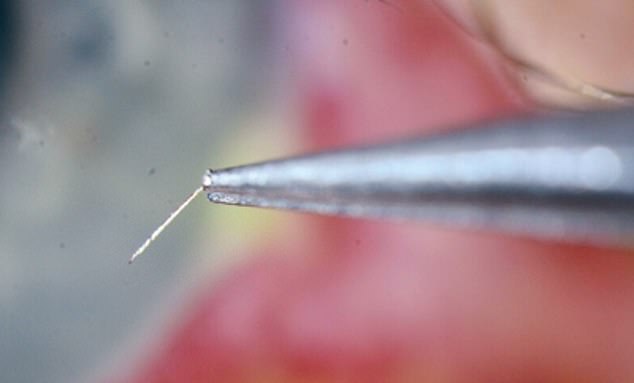Doctors remove bee stinger from Philadelphia man’s EYEBALL after bleed nearly blinds him
A 55-year-old Philadelphia man was nearly blinded after a bee stinger lodged in his eye and had to be removed with tweezers.
The man presented to the emergency room with “worsening vision and pain” and the stinger was quickly identified, but doctors were unable to remove it entirely because it was lodged in the edge of his iris, or the colored part of his eye.
Two days later, the man was admitted to Wills Eye Hospital in Philadelphia, still in pain and nearly blind in his right eye.
Further investigation revealed that the man was suffering from dangerous bleeding in his eye and that the small blood vessels were damaged.
The side of the eye closest to the nose still had some of the stinger in it, which looked yellow after the eyes were painted, as indicated by an arrow in the image

The doctor removed the remaining part of the stinger with jeweler’s tweezers, but his eye was still inflamed and he required further treatment with an ophthalmologist
Doctors discovered the damage by a comprehensive eye examination using a slit lamp and fluorescein dye, during which any damage is highlighted by staining it yellow-green.
He was suffering from redness in the white part of the eye, also known as conjunctival injection.
He also had severe swelling in the inferior part of the cornea, the clear, dome-shaped front part of the eye that covers the iris, pupil and anterior chamber.

Stingers are small, but doctors took a picture with a magnification of 100 times
On the side of the eye closest to the nose, part of the stinger was still attached. After the eyes were painted, they looked yellow, as indicated by an arrow in the image.
In addition, there was bleeding in the eye, probably caused by damage to the iris by the stinger and bleeding from the iris vessels, indicated by an asterisk in the image.
The stings are small, but doctors took a picture with a magnification of 100 times.
They range in size from 1.5 to 3 mm, about one-sixteenth to one-eighth of an inch.
Doctors prescribed the man antibiotic eye drops and drops containing prednisolone, a corticosteroid used to treat inflammation.
They said, ‘At 5-month follow-up, visual acuity in the right eye had improved to 20/25.’
Bee stings in the eye are rare and there are few case studies describing this.
Stingers have barbs so they can cut through tissue and embed themselves in the eye.
Normally, when the stinger enters a human’s skin, or in this case the eye, most of the bee’s intestines are pulled out of the body and the bee dies.
Bee, wasp and hornet stings contain venom.
Venom can cause significant damage to the cornea, iris and retina, which can lead to blindness.
This damage can also cause scarring, which can also be a possible cause of vision loss.
